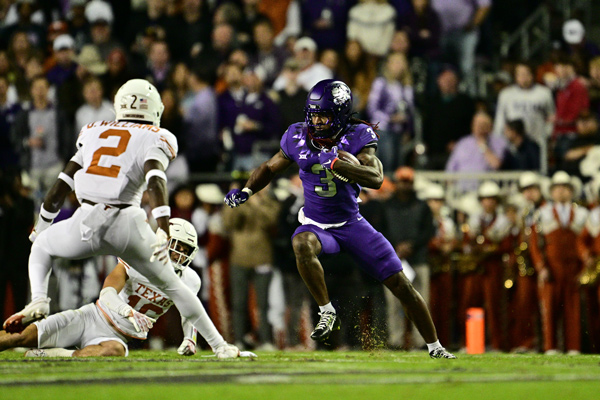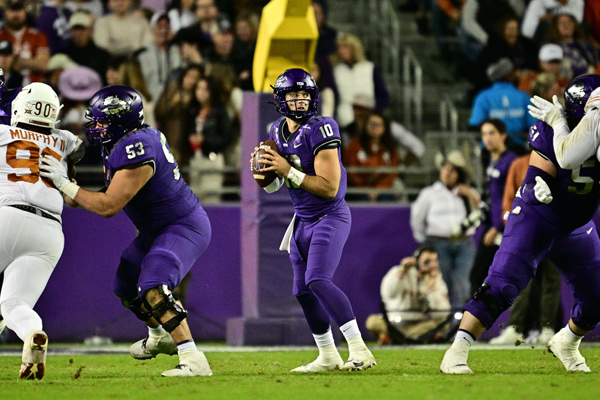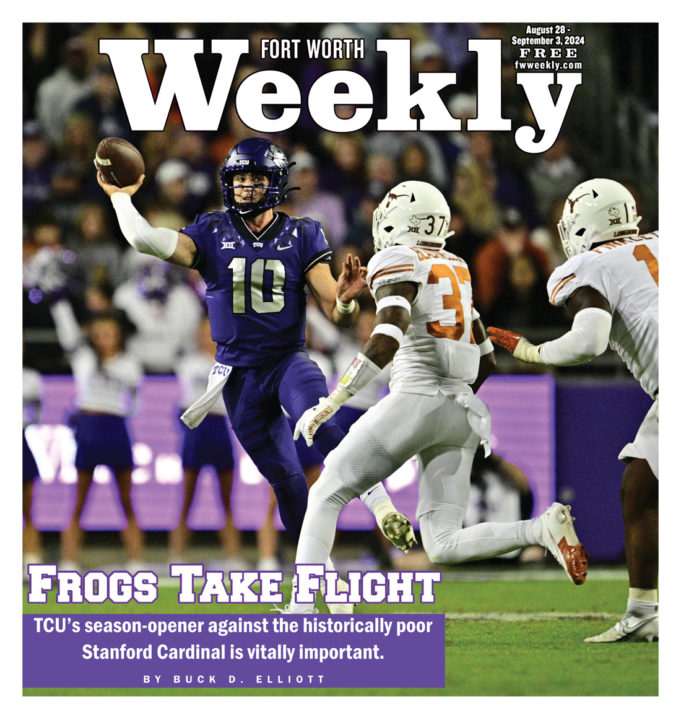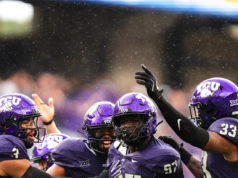Michael Scott said it best: “I’m ready to get hurt again.” Though compared to last season’s experience that combined the cautionary fables of Icarus’ wings melting before being crushed by Sisyphus’ stone, Purple Nation should approach this year with mostly cautious optimism. Tenth-ranked Florida State couldn’t even make it to Week 1 without their hopes drowning in a keg of Guinness, and new Power 5’er SMU needed a 16-point fourth quarter to survive Nevada. Save for maybe three or four teams in this every-season-transfer era, no one knows a damn thing about who is good and who isn’t.
If you’re not the type of fan who peruses message boards in the offseason and obsesses over three-deep lineups, transfer rumors, and who is already signed to the class of 2032, let me catch you up on the things that matter most for the conference, because the neighborhood has changed a lot. The conference — which desperately needs a different name — is no longer 10 teams who play in a round robin but 16 who’ll compete in a semicircle. Oklahoma and Texas packed up their money bags and absconded for the SEC. The Big 12 added Arizona, Arizona State, Colorado, and Utah, all from the effectively deceased PAC 12. There are no divisions yet, and each member is supposed to play all conference opponents twice in a four-year period. There are four projected rivalries, or teams who will play each other every year. TCU and Baylor and Kansas State and Kansas are the familiar pairings. The others are Arizona State against Arizona and BYU keepin’ it holy against Utah.
There is an expanded 12-team playoff starting this season which includes all Power 5 champions receiving an automatic bid, along with Seeds 6 through 12. The top four teams (who used to be the only participants) will have a bye while the rest play in a bracket format (5 v. 12, 6 v. 11, and so on). The playoffs begin before Christmas, the quarterfinals around the New Year, and the semifinals in the second week of January, when the old championship game took place. The new championship will be later that month. Gone are the days of bellyaching if your squad is dropped from the top four, but the new format involves many fanbases in the mix as 2-loss Power 5 teams and 0- or 1-loss Group of Five squads will make their case to crack the dirty dozen and gain their shot at the first expanded playoff.

For TCU specifically, Joe Gillespie (now head coach of Waco Midway High School) is out as defensive coordinator, and Andy Avalos (former head coach of Boise State and coordinator at Oregon) is in. Josh Hoover, who was the starting Frog quarterback the majority of last year after Chandler Morris succumbed to injury again, has earned the starting job and is sitting at the head of a quarterback room of all Texas products as the only returner from last season. The offensive line is a veteran group of almost completely new faces. Wait, that doesn’t make sense … Senior Mike Nichols is the only returning lineman among a group of transfer juniors and seniors. The trenches were a weak point last season despite the talent and production of Emani Bailey (now with the Kansas City Chiefs).
Offensive coordinator Kendal Briles, who is in a make-or-break season, will be looking for more balance in the attack to take pressure off Hoover, who displayed tremendous upside but is not yet ready to toss the rock 50-plus times per game with success. Supporting the backfield is a committee of familiar faces, headlined by Cam Cook, a sophomore who suffered an injury early in his debut season but still saw limited action in nine games last year. Behind him are senior Trey Sanders, who transferred in with Briles from Arkansas last season, and Junior Trent Battle. Entering his fourth season at the same school — a rarity in today’s game — he’s listed as third but is a multi-tool threat, recruited as a quarterback but having spent time at special teams, receiver, and running back. Look for Cook to be fed most frequently and Sanders to be featured in short-yardage situations, while Battle can threaten as a change of pace through mid-game.
The receiving corps is the most proven offensive element, and the onus is on Savion Williams to fulfill expectations of a dominating presence a la Quentin Johnston, Jalen Reagor, Josh Doctson, and Corey Rodgers. Williams possesses the physicality and dexterity to be elite, but the connection with Hoover will determine how far he goes. Opposite Williams will be transfer Eric McAlister, who followed Avalos home — the receiver grew up in Azle — and racked up nearly 1,000 receiving yards on the blue turf last season. Senior JP Richardson returns in the slot. Having led all wideouts in yards last season — Kansas City Chiefs tight end Jared Wiley was the overall leader in that category — he rounds out what has the potential to be a difference-making group of on the offensive side of the ball for the Frogs.
TCU starts their season unceremoniously on a Friday night in Palo Alto against the Stanford Cardinal — is it a tree, a bird, a color, a failed experiment? No one really knows, except that it’s definitively not plural. Stanford is best known for rejecting brilliant students academically and playing football poorly, last season being no exception. The Cardinal narrowly escaped dead last in a conference that went the way of the tech bubble, but they beat Colorado, something the Frogs couldn’t do. Stanford also boasts homefield advantage but not in the traditional sense. The Farm, as their stadium is known, is one of the country’s most novel college football venues in that it’s basically an EV in a world of straight-pipe muscle cars. There will be hundreds of high school games happening simultaneously throughout Texas with more energy, passion, and volume from their crowds than what will emanate from NorCal on Friday. TCU will need to generate electricity, because the home crowd simply issues apathy. The expectation from the Frog faithful is that if this team is to meet minimum expectations (a bowl bid), then they’ll need to belch exhaust fumes all over the Stanford Volt if the purple even hopes to compete with the best of their conference foes.
This season’s resetting of expectations for Purple Nation should leave fanatics primed to consider a 7- or 8-win season a hopping success. Even with the expanded playoff, I wouldn’t expect even a third-place Big 12 squad to make the dozen. Most prognosticators are considering Kansas State and Utah to be the class of the conference, which is a sound prediction. TCU is kind of that “might be good second or third tier” along with Oklahoma State, Iowa State, Kansas, and UCF. The Frogs usually play a little better when they’re underestimated, but I think fulfilling their projected status of fourth or fifth in the newly expanded conference would be a great season for Dykes and company to build on, and no one on the current staff would need to be shopping for a new job for Christmas.














Great column, as usual. One nit to pick: Trey Sanders transferred in from Alabama, not Arkansas.
FWIW, Dominique Johnson is the RB who transferred to TCU from Arkansas, but did so just this summer, I believe.